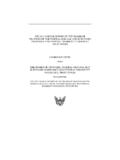Transcription of The Advantages and Disadvantages of Different Social ...
1 Throughout the world, societies are reexamining, reforming, and restructuring their Social welfare systems. New ways are being sought to manage and finance these systems, and new approaches are being developed that alter the relative roles of government, private business, and individ- uals. Not surprisingly, this activity has triggered spirited debate about the relative merits of the various ways of structuring Social welfare systems in general and Social security programs in particular. The current changes respond to a vari- ety of forces. First, many societies are ad- justing their institutions to reflect changes in Social philosophies about the relative responsibilities of government and the individual. These philosophical changes are especially dramatic in China, the former socialist countries of Eastern Europe, and the former Soviet Union; but The Advantages and Disadvantages they are also occurring in what has tradi- of Different Social Welfare Strategies tionally been thought of as the capitalist West.
2 Second, some societies are strug- by Lawrence H. Thompson* gling to adjust to the rising costs associated with aging populations, a problem particu- The following was delivered by the author to the High Level American larly acute in the OECD countries of Asia, Meeting of Experts on The Challenges of Social Reform and New Adminis- Europe, and North America. Third, some trative and Financial Management Techniques. The meeting, which took countries are adjusting their Social institu- tions to reflect new development strate- place September 5-7, 1994, in Mar de1 Plata, Argentina, was sponsored gies, a change particularly important in by the International Social security Association at the invitation of the those countries in the Americas that seek Argentine Secretariat for Social security in collaboration with the ISSA economic growth through greater eco- Member Organizations of that country. nomic integration. And, finally, in many parts of the world, Social welfare reform is motivated by the need to adjust the costs of * Deputy Commissioner of the Social security Administration.
3 The views welfare systems to economies that are no expressed in this article are the author's own and do not necessarily reflect those longer growing as fast as they did in the of the Government or the Social security Administration. first three or four decades after World War II. Whatever their motivation, these changes are being discussed and debated widely. And the current discussions seem in several ways to reflect a new level of sophistication about the complexities of Social welfare policy. One example of this is the recognition of the important relation- ships between Social welfare systems and the economy in which they exist. The state of its economy will often influence a soci- ety's willingness to support its Social wel- fare system. Healthier economies facilitate more generous Social welfare systems, while economic difficulties frequently lead, sooner or later, to retrenchments. At the same time, the size and structure of Social security Bulletin l Vol.
4 57, No. 3 Fall 1994. l 3. Social welfare systems can themselves decisions. But careful and objective variations) to structuring income support influence the pace and rate of growth of analyses of the many implications of programs.' I begin by describing briefly economic activity. Social welfare sys- each possible Social welfare option are each in turn. tems that inadvertently discourage work also very important. That conclusion activity --or encourage a shift from the emerged from a recent expert meeting hosted by the International Labor Office Social Insurance formal sector to the informal sector---can reduce the aggregate amount of income (ILO) in Mexico City. The experts noted Social insurance is the largest single available for distribution among society's that a key element of Social security element in and the foundation for the members. Similarly. a system which reform was: ..careful and rigorous ex- Social welfare system of most countries.
5 Discourages domestic savings can have ploration of all of the options-in a par- It grew out of voluntary insurance the effect of slowing economic growth, ticular country's context--considering arrangements of the medieval European while. given the proper environment, one [such objectives as] administrative ef'ii- craft guilds, was institutionalized by that increases domestic savings could ciency, cost containment, breadth of European governments in the late 19th enhance economic growth. coverage. and transparency .. and early 20th centuries, and soon spread Another indication of the increased My purpose in developing this paper from there to the Americas. Since Social sophistication of current debates is the is to contribute to the rational debate and insurance is the foundation of so many realization that Social welfare policies are discourse referred to in the IL0 commu- Social welfare systems, it seems the rea- developed to achieve a variety of differ- nique by developing further some of the sonable starting place for this discussion.
6 Ent and often competing Social objec- thoughts 1 have just outlined. In particu- Although details vary from one coun- tives. These Social objectives include the lar. 1 wish to suggest a framework for try to another, Social insurance programs effective protection of the population thinking about the various goals, objec- throughout the world share certain char- from various economic risks, the promo- tives, and structures and to offer some acteristics. The interaction of these char- tion of increased economic activity. the suggestions about the relative Advantages acteristics gives Social insurance a unique redistribution of economic resources, the and Disadvantages of Different ap- set of attributes, and the differences facilitation of the smooth operation of a proaches to achieving the various goals. between Social insurance and other Social free labor market, and the efficient opera- 1 seek to further the dialogue about welfare approaches can be traced prima- tion of Social institutions.
7 No single these topics by producing a document rily to differences in the mix of these policy will be best able to achieve all of that will provoke others to think and characteristics. Some expert commenta- these various objectives, so the choices react. Some may suggest the addition of tors cite seven characteristics as essential actually made will necessarily reflect important Social objectives that they elements of Social insurance. decisions, either implicit or explicit. believe I have overlooked. Others may about the relative importance of the vari- suggest additional ways in w-hich particu- 1. Compulsory participation. Most ous lar Social and economic structures may people participating in Social insurance Since assessments of the relative im- help achieve a given Social objective. All programs do so as a result of a legal portance of competing Social objectives such suggestions and elaborations will requirement. In some programs, a small will vary from country to country and help us to increase our understanding of minority may be allowed to choose from time to time, Social welfare policies these important issues.
8 Whether to participate.. appropriate in one time and place need Finally, in order to simplify (some- not necessarily be appropriate in another. what) an already complicated discussion, 2. Government sponsorship (and Moreover, the degree to which a particu- my analysis focuses almost exclusiveiq regulation). Governments create and lar approach to the Social welfare system on programs that supply cash benefits; supervise Social insurance programs, but does, in fBct, advance a particular objec- indeed the implicit focus is almost do not necessarily manage them. The tive will also vary from place to place exclusively on pension programs. Much programs may actually be operated and from time to time, Put simply, the of the discussion contained here would entirely by private sector institutions policy that is most effective in achieving be appropriate for other major Social (for example, the German health and a given objective in Argentina may not welfare programs, such as those con- pension systems); by a combination of achieve that objective in the United cerned with acute health care services.
9 Public agencies and private contractors States, and the people of the United But health programs also introduce (the model used for Medicare. the health States tnay wish to pursue a particular other issues that go beyond the scope of insurance program for the aged in the objective with their Social welfare system this paper, such as provider reactions to United States); or directly by a public that is not as important to the people of Different institutional arrangements. sector agency (the model used by Anglo- Argentina. No particular structure is the Saxon countries for operating their public most appropriate one at all times and in pension programs). Where the private The Competing Approaches all societies. sector runs these programs, however, Philosophical considerations will Most advanced societies rely on some operations are tightly supervised by the always he important to Social welfare combination of six approaches (or close public sector.)
10 4 Social Securit! Bulletin Vol. 57. No. 3. l l Fall 1994. 3. Contributory finance. Most- Social insurance schemes also subsidize Other characteristics combine to give sometimes virtually all-of the resources benefits for nonworking members of the Social insurance some of its key attri- needed to run the program are raised families of workers, students, members butes. For example, advocates of the through explicit contributions collected of the armed forces, homemakers caring Social insurance approach argue that it from the employer or from both the for children, and others whose activities delivers benefits in a way that promotes a employer and the employee. A worker's are deemed to be socially beneficial. sense of individual worth and dignity contribution is usually a fixed percentage among recipients. They argue that this of his or her wage or 7. Separate accounting and explicit result flows from the fact that Social long-range financing plan.















